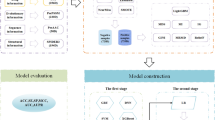Abstract
Identifying the interaction among drugs and target proteins is an important area of drug research, which provides a broad prospect for low-risk and faster drug development. However, due to the limitations of traditional experiments when revealing drug-protein interactions (DTIs), the screening of targets not only takes a lot of time and money, but also has high false-positive and false-negative rates. Therefore, it is imperative to develop effective automatic computational methods to accurately predict DTIs in the post-genome era. In this paper, we propose a new computational method for predicting DTIs from drug molecular structure and protein sequence by using the stacked auto-encoder of deep learning which can adequately extracts the raw data information. The proposed method has the advantage that it can automatically mine the hidden information from protein sequences and generate highly representative features through iterations of multiple layers. The feature descriptors are then constructed by combining the molecular substructure fingerprint information, and fed into the rotation forest for accurate prediction. The experimental results of 5-fold cross-validation indicate that the proposed method achieves superior performance on golden standard datasets (enzymes, ion channels, GPCRs and nuclear receptors) with accuracy of 0.9414, 0.9116, 0.8669 and 0.8056, respectively. We further comprehensively explore the performance of the proposed method by comparing it with other feature extraction algorithm, state-of-the-art classifier and other excellent methods on the same dataset. The excellent comparison results demonstrate that the proposed method is highly competitive when predicting drug-target interactions.
L. Wang and Z.-H. You––The authors wish it to be known that, in their opinion, the first two authors should be regarded as joint First Authors.
Access this chapter
Tax calculation will be finalised at checkout
Purchases are for personal use only
Similar content being viewed by others
References
Dickson, M., Gagnon, J.P.: Key factors in the rising cost of new drug discovery and development. Nat. Rev. Drug Discov. 3, 417–429 (2004)
Paul, S.M., Mytelka, D.S., Dunwiddie, C.T., et al.: How to improve R&D productivity: the pharmaceutical industry’s grand challenge. Nat. Rev. Drug Discov. 9, 203–214 (2010)
Kola, I., Landis, J.: Can the pharmaceutical industry reduce attrition rates? Nat. Rev. Drug Discov. 3, 711–715 (2004)
Chen, H., Zhang, Z.: A semi-supervised method for drug-target interaction prediction with consistency in networks. PLoS ONE 8, 5 (2013)
Chen, X., Liu, M.X., Yan, G.Y.: Drug-target interaction prediction by random walk on the heterogeneous network. Mol. BioSyst. 8, 1970–1978 (2012)
Iskar, M., Zeller, G., Zhao, X.-M., et al.: Drug discovery in the age of systems biology: the rise of computational approaches for data integration. Curr. Opin. Biotechnol. 23, 609–616 (2012)
Gao, Z.G., Wang, L., Xia, S.X., et al.: Ens-PPI: a novel ensemble classifier for predicting the interactions of proteins using autocovariance transformation from PSSM. In: Biomed Research International, p. 8 (2016)
Hopkins, A.L.: Network pharmacology: the next paradigm in drug discovery. Nat. Chem. Biol. 4, 682–690 (2008)
Yang, K., Bai, H.J., Qi, O.Y., et al.: Finding multiple target optimal intervention in disease-related molecular network. Mol. Syst. Biol. 4, 13 (2008)
Xie, L., Xie, L., Kinnings, S.L., et al.: Novel computational approaches to polypharmacology as a means to define responses to individual drugs. Annu. Rev. Pharmacol. Toxicol. 52, 361 (2012)
Chen, X., Ren, B., Chen, M., et al.: NLLSS: predicting synergistic drug combinations based on semi-supervised learning. PLoS Comput. Biol. 12, 7 (2016)
Chen, X., Yan, C.C., Zhang, X., et al.: Drug–target interaction prediction: databases, web servers and computational models. Briefings Bioinform. 17, 696–712 (2016)
Yamanishi, Y., Kotera, M., Kanehisa, M., et al.: Drug-target interaction prediction from chemical, genomic and pharmacological data in an integrated framework. Bioinformatics 26, i246–i254 (2010)
Wang, Y.-C., Yang, Z.-X., Wang, Y., et al.: Computationally probing drug-protein interactions via support vector machine. Lett. Drug Des. Discov. 7, 370–378 (2010)
Shen, J., Cheng, F.X., Xu, Y., et al.: Estimation of ADME properties with substructure pattern recognition. J. Chem. Inf. Model. 50, 1034–1041 (2010)
Gribskov, M., McLachlan, A.D., Eisenberg, D.: Profile analysis: detection of distantly related proteins. Proc. Natl. Acad. Sci. U.S.A. 84, 4355–4358 (1987)
Bengio, Y., Lamblin, P., Popovici, D., et al.: Greedy layer-wise training of deep networks. Adv. Neural. Inf. Process. Syst. 19, 153 (2007)
Rodriguez, J.J., Kuncheva, L.I.: Rotation forest: a new classifier ensemble method. IEEE Trans. Pattern Anal. Mach. Intell. 28, 1619–1630 (2006)
Zweig, M.H., Campbell, G.: Receiver-operating characteristic (ROC) plots: a fundamental evaluation tool in clinical medicine. Clin. Chem. 39, 561–577 (1993)
Cao, D.-S., Liang, Y.-Z., Xu, Q.-S., et al.: Exploring nonlinear relationships in chemical data using kernel-based methods. Chemometr. Intell. Lab. Syst. 107, 106–115 (2011)
Smola, A.J., Scholkopf, B.: A tutorial on support vector regression. Stat. Comput. 14, 199–222 (2004)
Cao, D.-S., Xu, Q.-S., Liang, Y.-Z., et al.: Prediction of aqueous solubility of druglike organic compounds using partial least squares, back-propagation network and support vector machine. J. Chemometr. 24, 584–595 (2010)
Gonen, M.: Predicting drug-target interactions from chemical and genomic kernels using Bayesian matrix factorization. Bioinformatics 28, 2304–2310 (2012)
Cheng, F., Liu, C., Jiang, J., et al.: Prediction of drug-target interactions and drug repositioning via network-based inference. PLoS Comput. Biol. 8, 5 (2012)
Öztürk, H., Ozkirimli, E., Özgür, A.: A comparative study of SMILES-based compound similarity functions for drug-target interaction prediction. BMC Bioinform. 17, 1–11 (2016)
Acknowledgements
This work is supported by the Fundamental Research Funds for the Central Universities (2017XKQY083).
Author information
Authors and Affiliations
Corresponding authors
Editor information
Editors and Affiliations
Rights and permissions
Copyright information
© 2017 Springer International Publishing AG
About this paper
Cite this paper
Wang, L. et al. (2017). Computational Methods for the Prediction of Drug-Target Interactions from Drug Fingerprints and Protein Sequences by Stacked Auto-Encoder Deep Neural Network. In: Cai, Z., Daescu, O., Li, M. (eds) Bioinformatics Research and Applications. ISBRA 2017. Lecture Notes in Computer Science(), vol 10330. Springer, Cham. https://doi.org/10.1007/978-3-319-59575-7_5
Download citation
DOI: https://doi.org/10.1007/978-3-319-59575-7_5
Published:
Publisher Name: Springer, Cham
Print ISBN: 978-3-319-59574-0
Online ISBN: 978-3-319-59575-7
eBook Packages: Computer ScienceComputer Science (R0)





